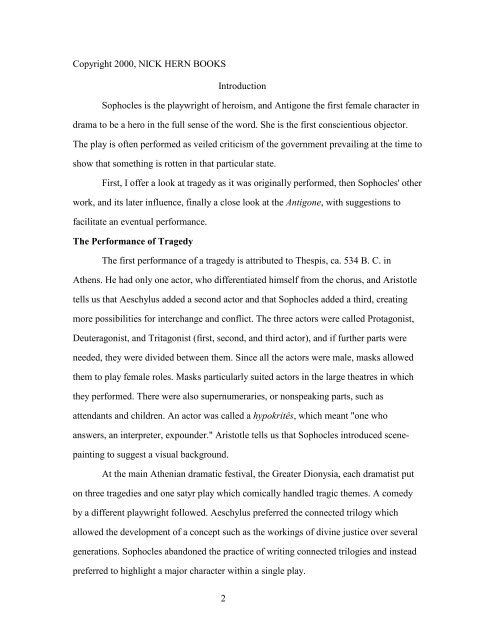1 Sophocles' Antigone Introduction, translation, and notes by ...
1 Sophocles' Antigone Introduction, translation, and notes by ...
1 Sophocles' Antigone Introduction, translation, and notes by ...
You also want an ePaper? Increase the reach of your titles
YUMPU automatically turns print PDFs into web optimized ePapers that Google loves.
Copyright 2000, NICK HERN BOOKS<br />
<strong>Introduction</strong><br />
Sophocles is the playwright of heroism, <strong>and</strong> <strong>Antigone</strong> the first female character in<br />
drama to be a hero in the full sense of the word. She is the first conscientious objector.<br />
The play is often performed as veiled criticism of the government prevailing at the time to<br />
show that something is rotten in that particular state.<br />
First, I offer a look at tragedy as it was originally performed, then <strong>Sophocles'</strong> other<br />
work, <strong>and</strong> its later influence, finally a close look at the <strong>Antigone</strong>, with suggestions to<br />
facilitate an eventual performance.<br />
The Performance of Tragedy<br />
The first performance of a tragedy is attributed to Thespis, ca. 534 B. C. in<br />
Athens. He had only one actor, who differentiated himself from the chorus, <strong>and</strong> Aristotle<br />
tells us that Aeschylus added a second actor <strong>and</strong> that Sophocles added a third, creating<br />
more possibilities for interchange <strong>and</strong> conflict. The three actors were called Protagonist,<br />
Deuteragonist, <strong>and</strong> Tritagonist (first, second, <strong>and</strong> third actor), <strong>and</strong> if further parts were<br />
needed, they were divided between them. Since all the actors were male, masks allowed<br />
them to play female roles. Masks particularly suited actors in the large theatres in which<br />
they performed. There were also supernumeraries, or nonspeaking parts, such as<br />
attendants <strong>and</strong> children. An actor was called a hypokritês, which meant "one who<br />
answers, an interpreter, expounder." Aristotle tells us that Sophocles introduced scene-<br />
painting to suggest a visual background.<br />
At the main Athenian dramatic festival, the Greater Dionysia, each dramatist put<br />
on three tragedies <strong>and</strong> one satyr play which comically h<strong>and</strong>led tragic themes. A comedy<br />
<strong>by</strong> a different playwright followed. Aeschylus preferred the connected trilogy which<br />
allowed the development of a concept such as the workings of divine justice over several<br />
generations. Sophocles ab<strong>and</strong>oned the practice of writing connected trilogies <strong>and</strong> instead<br />
preferred to highlight a major character within a single play.<br />
2









